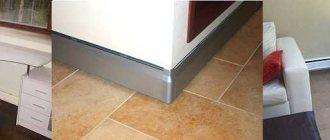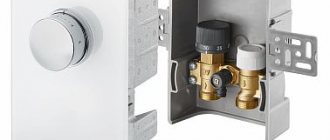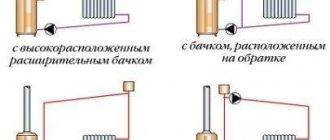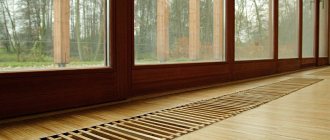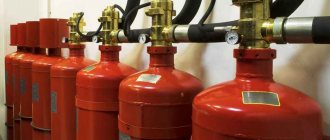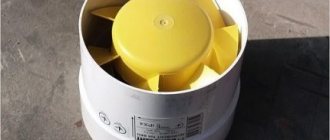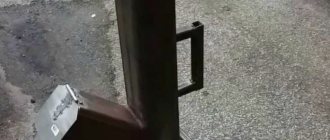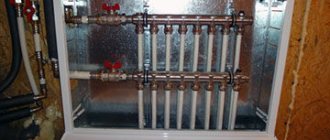Scope of application
Distribution manifolds are used as part of the following types of utility networks:
- water supply;
- water heated floors;
- heating systems with radiant wiring.
Installing a comb allows you to create an independent feed into each line. This helps to equalize pressure, ensure accurate distribution and regulation of supply to each device, and prevent a decrease in water temperature when opening the tap at other water intake points. A water distribution manifold simplifies repairs by allowing you to shut off the desired line without shutting down the entire network.
A Question of Choice
A high-quality distributor is capable of operating at high fluid pressure, has trouble-free shut-off valves, and a high degree of environmental safety when distributing water.
Before purchasing a collector, it is necessary to determine the number of water consumers to which an individual pipeline will be connected. Then you need to purchase a collector, the number of outlets of which is equal to the number of water consumers.
If the supply pipe is made of polypropylene, then the distributor should also be installed from this material. In the case where the supply pipe is metal, it is better to use a distributor made of copper alloy or stainless steel.
When choosing a distribution manifold, it is necessary to take into account such a design feature of these devices as the possibility of replacing the tap of each outlet. Otherwise, if one of them fails, the collector will need to be completely replaced.
Example of installing a comb in a bathroom
Types of combs
combs for hot and cold water
Water combs differ in:
- degree of sophistication;
- material;
- number of taps,
- center distance of bends (36 – 100 mm).
Thus, combs for far water supply can be made from:
- copper;
- become;
- brass;
- silumin;
- polypropylene.
The design of an elementary distribution comb for water supply is simple: it is a pipe with several outlets. The number of outlets can be from 2 to 4. This collector is designed only for distributing water flows and is easy to assemble yourself.
There are complex models of combs for far water supply with ball valves and with shut-off control valves required for each outlet. The taps operate only in two positions: on and off, and shut-off equipment allows you to change the flow intensity. According to consumers, the second option is more convenient. The most sophisticated models are equipped with mechanical or electronic sensors and are designed to work in heating and hot water supply systems.
If there are more than 4 plumbing fixtures in the house, several collectors are connected together. The great convenience of using such wiring is the ability to install a hidden water supply system. The comb stabilizes the water flow, reducing the likelihood of a water pipe break.
Where and how best to install the comb?
The location where the comb will be installed is best determined during the design of the plumbing system. But most often you have to install it into an existing circuit. The main criteria when determining a location are:
- accessibility for repair and installation;
- moderate or low humidity;
- load-bearing wall on which the comb can be mounted;
- additional lighting with the ability to carry out work in emergency mode.
Sometimes the comb is generally mounted in a separate room, or special manifold cabinets are installed specifically for it.
The combs are mounted on hot and cold water supply. To avoid confusion and for ease of use, manufacturers make models in different colors (red and blue).
The nuances of installing the comb:
- Installation must be carried out by a specialist. Without specialized knowledge, the average person will experience difficulties during installation.
- To secure the device to a mounting cabinet or wall, use mounting clamps.
- Installation of the unit is done without additional compaction.
- Separate collectors are installed for cold and hot water.
- In the plumbing circuit, this unit is mounted after the filter and pressure reducer.
- The distribution manifold is necessarily equipped with shut-off valves (regulating and shut-off type).
- In the case of equipping the water supply of a two-story house, there may be a need for a circulation pump.
Advantages and disadvantages of collector heating
Collector heating in an apartment or private house has pros and cons. Among the advantages of this system it should be noted:
- Maintainability. If a breakdown is detected, you can easily turn off a separate section of the pipeline without completely interrupting the operation of the system.
- Small cross-section pipes can be used. Since each branch leaving the distributor feeds only one radiator, for its installation it is possible to choose pipes of a small cross-section, and they can be easily placed in the screed.
- Easy to use. Due to the fact that each device has autonomous control, the home owner has the opportunity to set the temperature in any specific room. And if necessary, turn off heating devices in the room. Moreover, the temperature in the remaining rooms will remain the same.
- You can install a collector heating system for a private house with your own hands.
Economic costs are one of the disadvantages of this heating
In order to create several branches that have different characteristics, for example, different coolant pressure, distribution wiring with a hydraulic compensator is used. A hydraulic arrow is a capacious pipe where several independent branches are connected to the outputs.
Due to the fact that heated water reaches the radiators with minimal losses, the efficiency of the system increases. This allows you to reduce the boiler power, saving fuel costs.
The heating system also has disadvantages. The main ones:
- Pipe flow. In contrast to the classical connection, the pipe flow during the arrangement of the collector circuit increases by 2-3 times. The difference in costs is due to the number of premises involved.
- Circulation pumps are required, which will entail additional material investments.
If something happens to the pipes, you will have to open the floor
Another disadvantage is the dependence on electricity: even with the boiler running, the radiators will remain cold during a power outage. Therefore, these systems are not recommended for use in areas where power outages are common.
Types and qualifications of distribution combs
As mentioned above, the device is designed for cold and hot water. For even more convenient use, they are available in two colors - blue and red. This allows you to avoid confusion during installation and technical work, which makes life much easier in the future.
Types of combs are divided into 3 types:
with 2, 3 or 4 branches. The choice depends on the wishes of the owner and the number of water supply nodes in the room.
If in your case there are 5 nodes you don’t need to despair, there is a solution - you can purchase a comb with 2 and 3 outlets and connect them together during installation. A significant advantage of collector pipe routing is that thanks to it it is possible to install a hidden gasket. This is ideal for the previously planned interior of the room in which the comb will be installed.
From a safety point of view, the distribution comb is one of the safest pipe layouts. After its installation, residents are not in danger of burst pipes and hot water leaking out, since it stabilizes its flow. If the building has several floors, wiring should be installed on each of them. The design of the device is very convenient, the pipes go from the risers directly to the distributor, and only then to all existing plumbing fixtures in the house. When installing, it is important to maintain an equal distance between the comb and the final device.
What is it needed for
When installing water pressure systems, there is a rule: the total diameter of all branches should not exceed the diameter of the supply pipe. In relation to heating equipment, this rule looks like this: if the diameter of the boiler outlet fitting is 1 inch, then the system allows two circuits with a pipe diameter of ½ inch. For a small house heated only with radiators, such a system will work effectively.
In fact, there are more heating circuits in a private house or cottage: heated floors. heating of several floors, utility rooms, garage. When they are connected through a tapping system, the pressure in each circuit will be insufficient to effectively heat the radiators, and the temperature in the house will not be comfortable.
Therefore, branched heating systems are made using collector systems; this technique allows you to adjust each circuit separately and set the desired temperature in each room. So, for a garage, plus 10-15ºС is enough, and for a nursery, a temperature of about plus 23-25ºС is required. In addition, heated floors should not heat up more than 35-37 degrees, otherwise it will be unpleasant to walk on them, and the floor covering may become deformed. With the help of a manifold and shut-off temperature, this problem can also be solved.
Manifold groups for heating systems are sold ready-made, and they can have different configurations and the number of outlets. You can select a suitable collector assembly and install it yourself or with the help of specialists.
However, most industrial models are universal and do not always fit the needs of a particular home. Redesigning or modifying them can significantly increase costs. Therefore, in most cases it is easier to assemble it from separate blocks with your own hands, taking into account the characteristics of a particular heating system.
Manifold group for heating system assembly
The design of the universal collector group is shown in the figure. It consists of two blocks for forward and reverse coolant flow, equipped with the required number of outlets. Flow meters are installed on the supply (direct) manifold, and thermal heads are located on the return manifold to regulate the return water temperature in each circuit. With their help, you can set the required coolant flow rate, which will determine the temperature in the heating radiators.
The manifold distribution unit is equipped with a pressure gauge, circulation pump and air valves. The supply and return manifolds are combined into one unit with brackets, which also serve to attach the unit to a wall or cabinet. The price of such a block is from 15 to 20 thousand rubles. and if some of the taps are not used, its installation will be clearly impractical.
Leaders of sells
For an even clearer understanding of what a distribution comb is and how to choose the best device for yourself, you need to look at the recent sales leaders. From this information, you can find out what requirements must be met and what new functions have been added by manufacturers.
You will be presented with 2 types of distribution comb and distribution manifold, common throughout the world, which have the most modern functions:
- distribution comb for 2 pipes. Combines low price and excellent quality. The manufacturer is the famous company Rehau. The average price in Russia is 700 rubles. Serves to regulate the coolant on several circuits. You can connect to the device both ordinary cold water passing through pipes and a heated floor system, as well as other heating devices. Installation of the comb is facilitated thanks to the sliding sleeves with which it is attached to the pipes. Made of brass, this material is characterized by long service life and high strength.
- distribution manifold for 11 groups. Collectors have the same functions as combs, the only difference is in the number of connections - the collector has many more of them, connections are made in groups, for cold and hot water separately. Rehau has proven the high quality of its devices. This is evidenced by the numerous purchases by Russians of collectors and combs from their company. The Rehau Rautitan HLV distribution manifold branches out the circuits of radiator distribution systems. All devices have passed mandatory quality checks and necessary tests, including pressure testing in emergency situations. Just like the comb, the manifold of this company is made of brass, which indicates high quality and durability. The average price in Russia for the Rehau Rautitan HLV distribution manifold is 11,000 rubles. The kit includes: eurocone, ball valves, connecting nipples and built-in air valve.
The market of modern technologies is filled with new products every day; distribution combs and manifolds are supplemented with convenient functions for ease of use. They all have their positive, and in rare cases, negative qualities. To choose the right distribution comb or manifold for your home or apartment, you should learn as much as possible about these devices, then it will be difficult to make a mistake in your choice.
Making a distribution manifold with your own hands
The distribution manifold design is developed based on the number of heating circuits in your system. Assess where your heating boiler is located, what inlet and outlet pipes it has, how many heating circuits or indirect heating circuits will be used in the heating system. Perhaps you are planning to increase the number of circuits in your home, for example adding another room next year. Solar collectors, heat pumps and other devices can also be connected to the distribution system. We also consider all heat distribution systems, including warm water floors, heating radiators, fan coil units, and so on.
We are drawing up a diagram of our heating system, taking into account that each circuit has a hot water supply pipe and a return pipe.
When designing the system, do not forget to determine the location of additional equipment, such as an expansion tank, an automatic make-up valve, a drain and fill valve, a group of thermostats, and so on.
Performs spatial design, that is, we determine where and where pipes will be connected to our distribution manifold. Practice suggests that pipes for connecting a solid fuel boiler and for indirect heating are usually installed at the ends of the collector. If you have a wall-mounted gas or electric boiler in your system, it fits into the top or also into the end.
Based on the available information, we draw up a drawing of the future distribution manifold. It is convenient to use graph paper for this. The distance between the pipes should not be less than 10 centimeters, but they should not be spaced wider than 20 centimeters either. For one heating circuit, the distance between the supply pipe and the return pipe should not be less than 10 centimeters. It is desirable that groups of pipes of the same circuit be visually distinguished.
Collector design
The figure below shows an example of designing a distribution manifold into which six heating system circuits will be connected.
At the first stage, we draw two rectangles. This is the supply manifold and the return manifold.
supply manifold and return manifold
We design the connection of the boiler and indirect heating boiler on the manifold trunks. Do not forget to indicate on the drawing the cross-sectional parameters of future pipes.
connecting the boiler and indirect heating boiler
We design the connection of heating circuits and additional heating boilers. Don’t forget to indicate the cross-section of the pipes and the dimensions of the pipes. We sign all designed pipes.
connection of heating circuits and additional heating boilers
At the next stage, we design the connection of additional equipment. In our case, this is an expansion tank, a drain valve, a protective block, and a system thermometer
Please note that the coolant supply circuits are highlighted in red, and the return circuits are highlighted in blue
connecting additional equipment
This was a rough drawing. We check its correctness and transfer it completely to a new sheet of paper. It is based on this project that we will create our own distribution manifold.
Rules for connecting the distribution comb
The selection of the collector location must be based on the principle of equidistant location of the equipment from it.
If this requirement is neglected, then high pressure arises at more extended nodes of the system, which will negatively affect this area. Therefore, the permitted difference in lengths of pipe sections from the comb to the batteries should not violate the 1:2 proportion. Or, in other words, the length of the pipelines from the first radiator to the collector and subsequent batteries cannot be less than 2 times. If the specified characteristics are exceeded, it will not be possible to ensure accurate operation of the comb. If the house has many floors, the collector is installed on each of them. There are a number of methods for placing the distribution comb in the heating system: in a special installation cabinet or directly on the wall.
When installing the collector on the walls, specialized niches are made in them. To install the heating comb, determine a place above the floor level. In terms of dimensions, the niche must correspond to the dimensions of the comb, taking into account attachments and piping of heating pipelines. The space where the collector is located must certainly be dry. Usually, for these purposes, a corridor or an auxiliary room is chosen, where the distribution system will not disturb anyone.
In case the distributor is located in a transition, it is recommended to place a special metal cabinet with a door and holes for the input/output of pipelines in a niche. This design is usually equipped with special fasteners to securely fasten it.
Selecting a location
First of all, the water distributor must be installed in such a way as to maximize the length of each pipeline to the consumer. If this rule is neglected, then over longer sections the fluid pressure will differ significantly.
If the water supply is installed in a multi-storey building, then the collector is installed on each floor.
There are two ways to install a water comb:
- In the wall of the building.
- In the distribution cabinet.
The first installation option is used when the usable area of the room is limited, or the open installation of pipes and distribution boxes will significantly change the design of the room. In this case, a niche is built in the wall, which is closed with a valve, and if necessary, it will be possible to gain access to the control of the device.
If it is possible to install the distribution device in a utility room, then in this case a special box is installed, inside which the comb and all the pipes leading to this device are fixed.
If the water supply is installed in a multi-storey building, then the collector is installed on each floor
Distribution comb for heating: recommendations for placement and installation
The comb is installed in accordance with existing SNIP standards and requirements for the arrangement of heating systems. It must meet certain requirements:
- The heating distribution comb must be located above the level of the main heating line. This requirement is necessary so that, in an emergency, it is possible to bleed excess air from the system.
- The longest duration of any circuit connected to the collector must be equal.
- After the installation of the heating comb is completed, the entire necessary set of additional equipment is connected to it: an electric circulation pump, shut-off and control valves, safety valves and air vents.
- Before commissioning, it is necessary to fine-tune the operation of the collector and auxiliary equipment according to the manufacturer’s recommendations.
How not to make a mistake when choosing a distribution comb
Before purchasing a device, you need to calculate all the important aspects of its functioning and set the comb parameters that will be required in the future for the automatic operation of the heat supply system. At the same time, you will need to pay a lot of attention not only to the material from which the heating comb is made, which, of course, is important, but not critical, but also to other important points.
Initially you need to pay attention to the following aspects:
- The volume of coolant passed through - it is necessary that the collector can cope with the heating flow of water through all heating circuits, and having a reserve of at least 15%.
- Ability to increase the heating system when connecting new subscribers.
- Total power consumption to ensure inter-circuit operation of servomotors.
- Maximum medium pressure with a margin of at least 15%.
As is obvious, the professional selection of a heating distribution comb can only be performed by specialists with experience in working with heating distribution networks
The heating distribution comb is an innovative component in domestic heating systems. Its use helps to automatically, including remotely, control the heating mode in each room separately, while ensuring a comfortable indoor air temperature and real savings on heating services.
Price
General Fittings Cold Water Manifold - The manifold is designed for use in a cold water system only. The material from which the device is made – nickel-plated brass – does not interact chemically with impurities in water, thereby allowing the device to be used for at least 10 years.
The comb is equipped with valves that are located on the main distributor pipe. The number of pins of this device is 4 pcs., but if necessary, a block of an unlimited number of pins can be assembled from separate sections.
The price of the comb is 1400 rubles.
Distribution manifold DM, Gidruss is a universal device that can be used for distribution of water supply and heating systems. The material from which the distributor is made is structural steel, capable of withstanding coolant temperatures up to + 120 degrees. The pressure in the water supply system when installing this device should be no more than 6 bar.
Famous brands
Valtec is an Italian manufacturer of a line of products for constructing water supply systems. A full range of products for metal-plastic, polypropylene water supply and stainless steel systems is always on sale. In Russia, representative offices are located in 6 cities, including Moscow, St. Petersburg, and Krasnodar.
Rehau is a German manufacturer with a history dating back to 1948. Products undergo multi-stage quality control.
Far (FAR) is another Italian company. In addition to shut-off and distribution valves, the line includes metal-plastic, polypropylene, copper and steel pipes.
How to make a distribution manifold yourself
For a good craftsman, making a homemade comb from metal or polypropylene will not be particularly difficult. Judge for yourself: a large-diameter steel pipe is plugged at both ends, after which connecting fittings with the thread that is most convenient for you are welded to it. The collector is then pressure tested for the permeability of the welds and painted over a layer of primer.
When performing this work, it is important to maintain the size and diameter of the pipes. You can be guided by this rule: the diameter of the collectors must be selected so that it is three times the diameter of the connected pipelines. In case you take profile pipes for production, we note that this proportion is also observed in relation to the cross-sectional area. To comply with the remaining dimensions, you can take the following diagram as a basis:
There is another option for selecting the diameter of the comb; it was discussed above in the example of a factory product. If the thermal power of the home heating system does not exceed 50 kW, then feel free to take a DN80 pipe, and above 50 to 100 kW, make a manifold from a DN100 pipe. In this case, the dimensions of the fittings do not need to be made three times smaller; take them in accordance with the hydraulic calculation.
A little more work needs to be done to make a comb from polypropylene tees. Such products are becoming more and more popular due to their low cost. You will only have to spend money on tees; all other parts will be inexpensive. By the way, similar collectors are already available for sale in assembled form.
Another thing is that a polypropylene comb, assembled with your own hands, is not able to withstand the high temperature of the water in the heating system. If an emergency occurs, the solder joints will immediately leak. This is quite likely when the house is heated with a solid fuel boiler, then the entire piping should be made of steel or copper.
